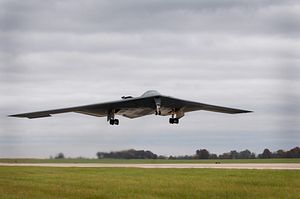As the United States contemplates how to address China’s recently declared Air Defense Identification Zone (ADIZ), the importance of America’s nuclear-capable bombers is once again on the rise. Recent efforts by advocacy groups like the CATO Institute, Union of Concerned Scientists, and Federation of American Scientists to carpet-bomb the nation’s capital with deeply flawed studies advocating dangerous reductions in the nuclear arsenal and the elimination of the ICBM and bomber legs of the nuclear triad may prove shortsighted. In advocating the elimination of the triad’s bomber leg, these detractors of the nuclear arsenal are advancing a false proposition, which suggests that strategic bombers are no longer relevant to nuclear deterrence and deterring Chinese aggression. Such arguments are, however, utterly false and, in fact, they advocate a very dangerous proposition.
The reality is, strategic bombers are as relevant to nuclear deterrence today as they were at the height of the Cold War. Simply stated, they provide the nation unparalleled flexibility, a high degree of responsiveness, and the only means of signaling during an escalating confrontation.
Flexibility
If recent experience is any guide to the future, the timing and locations of international crises – like the declaration of China’s ADIZ – will prove extremely difficult to predict. This means that the mobility strategic bombers provide (flying through the ADIZ soon after its declaration) ensures the president has flexibility in his options. This flexibility far exceeds that of either ICBMs or SSBNs.
Strategic bombers can carry a wide variety of weapons, from conventional to nuclear and from traditional gravity bombs to long-range standoff weapons like air-launched cruise missiles. Also important is the fact that strategic bombers carry the only variable yield nuclear weapon, which means the president can use a low yield nuclear weapon instead of being constrained by the large yields of intercontinental or submarine launched ballistic missiles.
Additionally, bombers eliminate the need to overfly Russia or China, should the target be elsewhere, and they are the only recallable delivery platform.
Responsiveness
To the extent that an attack against an adversary is a function of politics, the military tools employed to support it must be responsive to the president and his need for flexible attack options. Strategic bombers can fly airborne alert, ready to proceed to any target at a moment’s notice, or deploy forward as a coercive measure as the president seeks to deescalate a conflict, which has occurred twice in East Asia during 2013. Although SSBNs and ICBMs are also responsive, their application in a crisis is very limited and offers the president very few options in an escalation/de-escalation scenario.
Given the bomber’s ability to cover great distances quickly, free of the obstructions of surface terrain, the only real challenge they face are anti-aircraft defenses, which are yet to detect the United States’ stealth bombers. Because they are mobile and can carry a wide array of weapons, an adversary’s ability to plan a defense against American bombers is exceedingly difficult.
Should the United States learn that an adversary has deployed his anti-aircraft forces in just the right place to defend against incoming bombers, the mission can be changed and weapons can be reprogrammed in mid-flight as attacking bombers go around the threat. The same cannot be said of either ICBMs or SLBMs. They simply do not have the flexibility or responsiveness of the bomber force.
Signaling
The final characteristic of the bomber force that makes it the nation’s single best nuclear weapons delivery platform is its ability to signal adversaries of American intent, a particularly important characteristic in the current dispute with China. For deterrence to be effective, it is imperative that a nation be able to send a clear message to the country that is about to be on the receiving end of an American attack. Nothing demonstrates American resolve better than putting fully loaded strategic bombers on alert or deploying them to a forward base as the spy satellites of a target nation pass overhead. The ability to signal in a nuclear crisis is a characteristic found only in the bomber force.
By their very nature, SSBNs and ICBMs are designed to be stealthy and hidden from view. Consequently, their utility in an escalation/de-escalation scenario is extremely limited. In fact, the range of missions in which either could be employed and the kinds of attacks and weapons effects they could create are very limited. Although initially flushing submarines from port or increasing the alert posture of the ICBM force could signal American concern during a crisis, little more can be done with these weapons systems after that to send a clear message to an adversary.
In terms of signaling, strategic bombers also enhance the effectiveness of coercive threats. Absent the ability to clearly communicate both the will and the capability to carry out an attack, coercion does not work. Therefore, to be an effective tool in crisis management, strike assets need to be employable in ways that visibly communicate one’s capability, resolve, and restraint. Only nuclear capable bombers can effectively perform this function.
Thus, it is strange to see organizations that claim to understand how best to maintain an effective nuclear deterrent, while also expressing concern about Chinese aggression, advocating a nuclear force composed of ballistic missile submarines alone. It is simply poor strategic logic.
The conclusions and opinions expressed in this document are those of the author. They do not reflect the official position of the US Government, Department of Defense, the United States Air Force, or Air University.

































